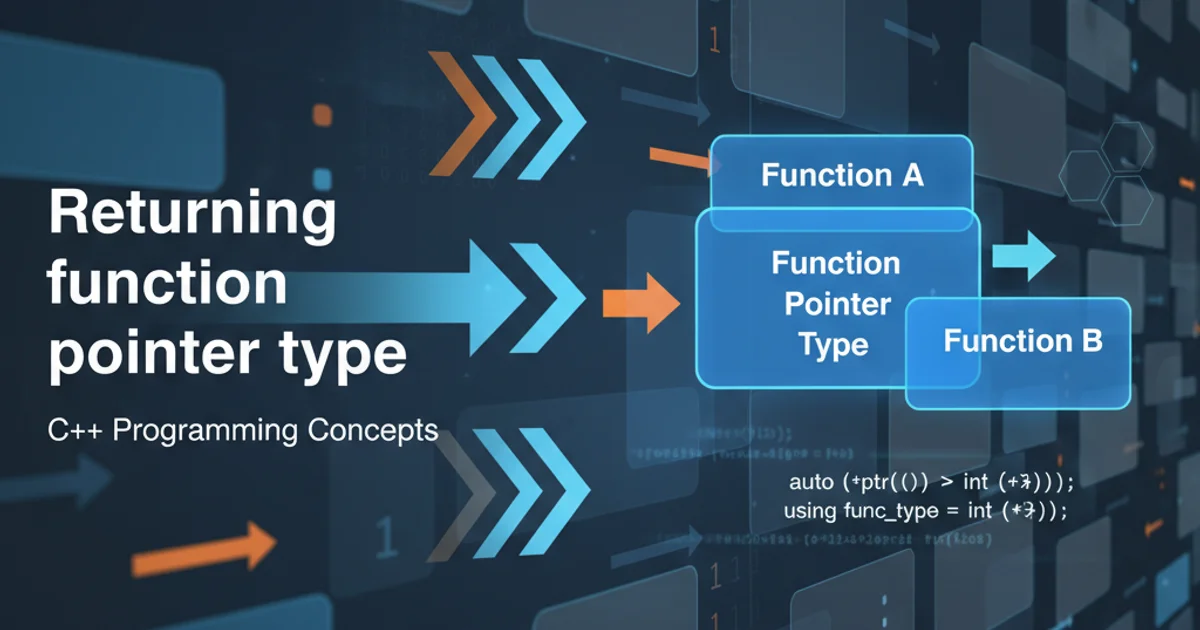Returning function pointer type
Categories:
Mastering Function Pointers: Returning Function Pointers in C

Unlock the power of advanced C programming by understanding how to declare, define, and return function pointers, enabling flexible and dynamic code structures.
Function pointers are a powerful feature in C that allow you to treat functions as variables. While declaring and using basic function pointers is common, returning a function pointer from another function can be a source of confusion due to the complex syntax involved. This article will demystify the process, providing clear explanations and practical examples to help you master this advanced C concept.
Understanding Function Pointer Syntax
Before we delve into returning function pointers, it's crucial to have a solid grasp of their basic declaration. A function pointer declaration specifies the return type of the function it points to, its name (prefixed with an asterisk and enclosed in parentheses), and the types of its parameters. The parentheses around *ptr_name are essential because * has lower precedence than (), so int *ptr_name(int) would declare a function named ptr_name that returns a pointer to an int, rather than a pointer to a function.
int (*func_ptr)(int, int); // func_ptr is a pointer to a function that takes two ints and returns an int
Basic function pointer declaration
Declaring a Function That Returns a Function Pointer
The syntax for a function that returns a function pointer can look intimidating at first. The key is to read it from the inside out, or to use typedef for clarity. Without typedef, the declaration follows a pattern where the return type of the outer function is itself a function pointer type. This means you're essentially embedding the function pointer declaration within the return type position of the function signature.
flowchart LR
A[Function Declaration] --> B{Return Type}
B --> C[Function Pointer Type]
C --> D[Return Type of Pointed Function]
C --> E[Pointer Name (e.g., *func_ptr)]
C --> F[Parameter List of Pointed Function]
B --> G[Outer Function Name]
B --> H[Parameter List of Outer Function]
style C fill:#f9f,stroke:#333,stroke-width:2px
style D fill:#ccf,stroke:#333,stroke-width:2px
style E fill:#ccf,stroke:#333,stroke-width:2px
style F fill:#ccf,stroke:#333,stroke-width:2pxBreakdown of a function returning a function pointer declaration
int (*getOperation(char op_code))(int, int);
// Explanation:
// 1. `getOperation(char op_code)`: This is the function being declared.
// 2. `(*getOperation(char op_code))`: This indicates that `getOperation` returns a pointer.
// 3. `int (*getOperation(char op_code))(int, int)`: This indicates that the pointer returned by `getOperation` points to a function that takes two `int`s and returns an `int`.
Direct declaration of a function returning a function pointer
Simplifying with typedef
The direct declaration syntax can be hard to read and maintain. The typedef keyword provides a much cleaner and more readable way to define complex types, including function pointer types. By creating an alias for your function pointer type, you can then use this alias in your function declarations, making the code significantly more understandable.
typedef int (*OperationFunc)(int, int);
OperationFunc getOperation(char op_code);
// Explanation:
// 1. `typedef int (*OperationFunc)(int, int);`: Defines `OperationFunc` as a type for a pointer to a function that takes two `int`s and returns an `int`.
// 2. `OperationFunc getOperation(char op_code);`: Declares `getOperation` as a function that takes a `char` and returns an `OperationFunc` (i.e., a function pointer of that specific type).
Using typedef to simplify function pointer declarations
typedef when dealing with complex pointer declarations, especially function pointers. It greatly improves code readability and reduces the chance of syntax errors.Implementing and Using the Function
Once declared, implementing the function that returns a function pointer involves simply returning a pointer to an existing function that matches the specified signature. This pattern is often used to create a 'factory' function that dispatches different operations based on some input criteria.
#include <stdio.h>
// Define the functions that our function pointer will point to
int add(int a, int b) {
return a + b;
}
int subtract(int a, int b) {
return a - b;
}
// Using typedef for clarity
typedef int (*OperationFunc)(int, int);
// Function that returns a function pointer
OperationFunc getOperation(char op_code) {
if (op_code == '+') {
return add;
} else if (op_code == '-') {
return subtract;
} else {
return NULL; // Or handle error appropriately
}
}
int main() {
OperationFunc op_add = getOperation('+');
OperationFunc op_sub = getOperation('-');
OperationFunc op_mul = getOperation('*'); // Will return NULL
if (op_add != NULL) {
printf("Addition: 10 + 5 = %d\n", op_add(10, 5)); // Calls add(10, 5)
}
if (op_sub != NULL) {
printf("Subtraction: 10 - 5 = %d\n", op_sub(10, 5)); // Calls subtract(10, 5)
}
if (op_mul == NULL) {
printf("Operation '*' not supported.\n");
}
return 0;
}
Complete example of returning and using a function pointer